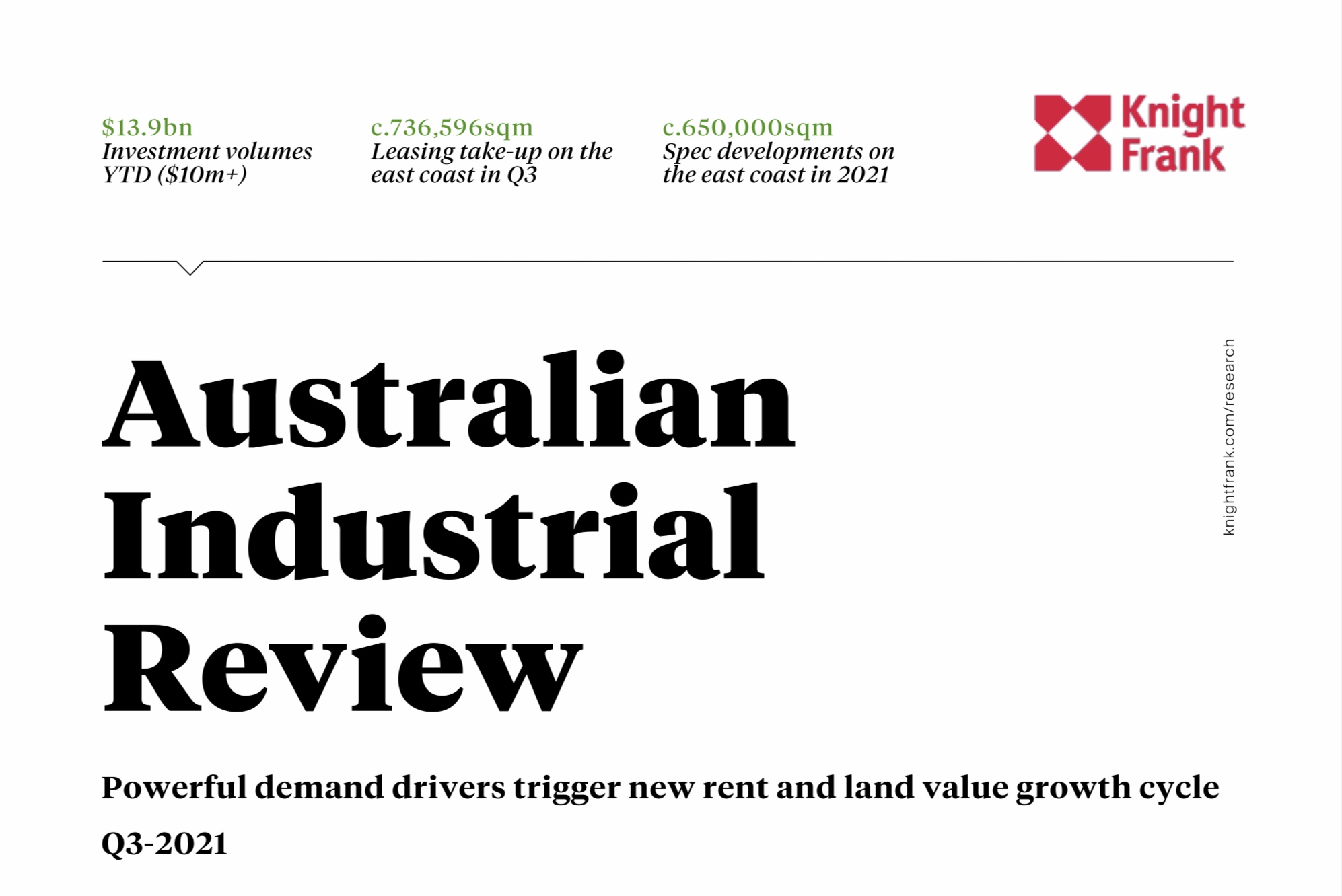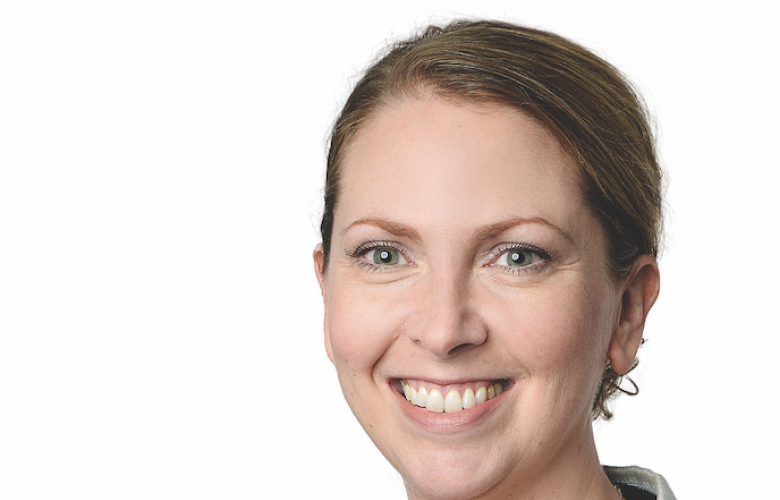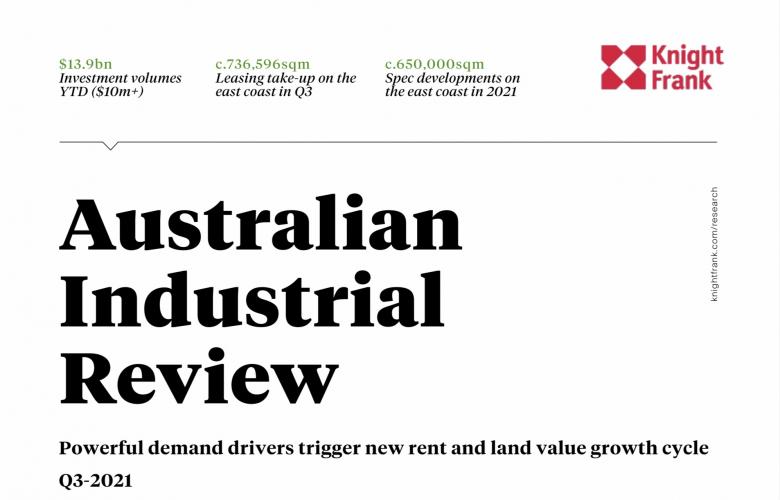Australia’s industrial sector 2021 investment $14 billion almost double the pre-pandemic high says Knight Frank
Contact
Australia’s industrial sector 2021 investment $14 billion almost double the pre-pandemic high says Knight Frank
Katy Dean Director Head of Industrial Research at Knight Frank Australia, said: “We are seeing competition for industrial stock continue to intensify, with take-up of existing stock rising 25% above the five-year average in Q3 to 500,000sqm on the east coast.”
As the Australian economy begins to recover from the effects of the pandemic, demand for the industrial sector from developers, investors and tenants is expanding rapidly as e-commerce continues its growth trajectory across the country and into new industries, and as ongoing supply chain disruptions drive up inflation.
Investor demand for industrial and logistics real estate is exceptional, with the unprecedented interest in this sector taking investment volumes to almost $14 billion so far in 2021 – already representing a 72% increase on the pre-pandemic high of $8 billion in 2019. Transactions have been focused on the eastern seaboard, with 82% of this investment volume taking place in these markets.
Katy Dean, Director, Head of Industrial Research at Knight Frank Australia, said: “We are seeing competition for industrial stock continue to intensify, with take-up of existing stock rising 25% above the five-year average in Q3 to 500,000sqm on the east coast. This, in turn, is pushing some markets like Sydney’s Western precincts and Melbourne’s West and South East to a critical shortage of prime existing stock, and therefore compressing the volume of available secondary supply considerably too. This is also evidenced on the east coast, where the volume of available secondary supply (+5,000sqm) has now dropped to its lowest level since 2011 after declining almost 45% over the last 12 months alone.
“Record volumes of investment capital continue to flow into the industrial sector too, with investors also pushing up prices through acquisition and development activity. This demand has created powerful tailwinds in Q3, resulting in further contraction of vacant space and the return of rental growth rates of 1-2% over the quarter in most markets. We expect to see further strong rental growth and investor interest in this sector throughout 2022, underpinned by low vacancy, supply constraints, the continued expansion of e-commerce, and intensifying competition for space,” she said.
Against the backdrop of low vacancy and inflationary pressures, a shortage of zones and serviced land has led to strong land value growth in Q3, with the average aggregate price of small lots increasing 4.1% and 1-5ha lots increasing 5.8%. This growth trajectory will continue, with much higher rates of growth expected in those precincts facing critical land shortages in the short-term.
This demand for space is flowing into future supply plans, with the forecast development pipeline in 2022 set to reach a new high with ~2.6 million sqm planned. While pre-commitment leasing take-up on the east coast was ~240,759sqm in Q3, down from an extraordinary high of 551,497sqm in Q2, the volume of available vacant supply declined for the fourth consecutive quarter, dropping 2.8% in aggregate to its lowest level since January 2013.
Ms. Dean continued: “The rate of compression of super prime yields has begun to slow, but on a year-on-year basis is still showing an average 116bps compression since Q3 last year. In Q3, Melbourne super-prime yields have compressed 50bps, while Perth and Adelaide have compressed 25bps to average 4.75%, Brisbane has compressed 5bps to 4.2% and Sydney is holding at 3.75%.
“There remains a question mark on how low yields can go in Australia – the market will retain its strong momentum but with yields at these low levels there may be limited scope for further downward movement in 2022, particularly in Sydney and Melbourne.”
In Sydney industrial leasing activity is surging, with leasing volumes already at 1.05 million sqm, eclipsing the total volume for 2020. Pent-up demand lifted take-up rates to 81% above the same period last year in Q3, and land values in Western Sydney have increased by 8% for 1-5ha lots to between $775-$850 per sqm on average (up 14.6% Y/Y). However, zoned and serviced land is in short supply, and this is seeing some sites sell for in excess of $1,000/sqm suggesting that there will be significant growth in land values in Q4, into 2022. Sydney has also reached a new record low of vacant supply, with strong tenant demand in Q3 resulting in an 8% decline quarter-on-quarter to 201,248sqm – a 71% fall year-on-year. The bulk of leasing activity in Sydney remains in the Outer West and South West.
As leasing demand reaches unprecedented levels, Melbourne industrial land values have skyrocketed, driven by developer appetite for the west and north regions, with the transport and warehousing sectors dominating. A surge in development is shortly to follow, with 1,172,297sqm of new industrial space to be delivered this year, and the pipeline forecast to rise further in 2022 to 1,319,855sqm. In Melbourne, the land value of 1-5ha lots has risen by 67% and 54% since the start of 2021. Alongside this, the take-up of vacant space has risen by 61% compared to Q3 2020, and leasing volumes have also increased by 9% year-on-year – focused mainly in the growing industrial west region with 71% of all take-up here.
In Brisbane, leasing activity remains high with rolling 12-month take-up 58% higher than a year ago and Q3’s take-up of 224,031 sqm 67% above the five-year average. Vacancy is now 29% below the levels of a year ago despite significant speculative projects starting development, which are expected to account for more than a third of the pipeline in 2022. Land ready for immediate development continues to be highly sought after with prices up 22% in the past year for 1-5ha blocks.
The industrial market in Perth has been flagged by a landmark deal this quarter, with Dexus and APN Industria REIT partnering to buy a $1.5 billion portfolio of industrial properties, showing that demand for this sector is not just confined to the eastern seaboard. As leasing demand gains momentum in Perth and a new rental growth cycle emerges, growing confidence in the occupational demand profile triggers sizeable yield compression and pushes up land rates for small lots by 4.7% in Q3. Investors are interested in markets with solid underlying drivers that will support demand from tenants over the long-term and Perth remains very compelling on that front.
In Adelaide, industrial land supply remains constrained with small lots growing on average 6.8% q/q and 1-5ha lots increasing 5.9%. Developers and owner occupiers are increasingly looking to brownfield sites where possible, and several speculative developments are underway with developers’ confidence buoyed by early leases prior to practical completion.
Across the board in the Australian industrial market, powerful demand has triggered new rent and land growth cycles which are expected to continue through Q4 and into 2022.
For a copy of The Australian Industrial Review please contact Katy Dean, Director, Head of Industrial Research at Knight Frank Australia via the contact details below:
 I
I








